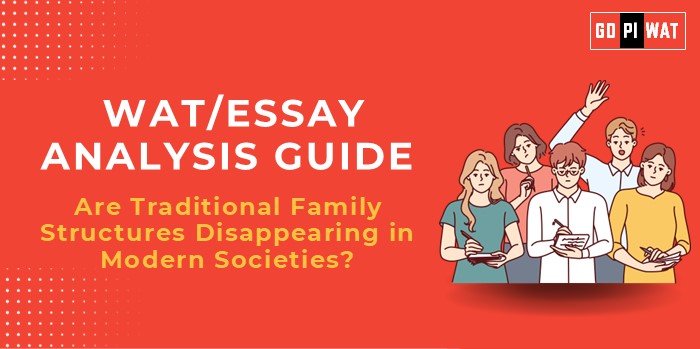📋 WAT/Essay Analysis Guide: Are Traditional Family Structures Disappearing in Modern Societies?
🌐 Understanding the Topic’s Importance
Family structures form a cornerstone of social dynamics, influencing everything from consumer patterns to workforce participation. The transformation of traditional family roles, often due to urbanization and changing social norms, makes this topic crucial for B-school students, linking to discussions on societal adaptation, economic planning, and workplace management.
🖋️ Effective Planning and Writing
- Time Allocation:
- Planning: 5 minutes to outline main points.
- Writing: 20 minutes for structured development.
- Review: 5 minutes to ensure clarity and coherence.
- Preparation Tips:
- Collect recent data on family structure changes globally.
- Identify significant stakeholders, such as government and social organizations.
📚 Introduction Techniques for Essays
- Contrast Introduction: “While traditional families once thrived as multi-generational units, today, economic demands and individualistic values are leading more people to opt for nuclear or alternative family models.”
- Solution-Oriented Introduction: “As traditional family structures evolve, governments and workplaces must create policies to support diverse family needs.”
- Historical Timeline Introduction: “From large kinship groups to single-family homes, family structures have adapted continuously over centuries, reflecting societal and economic transformations.”
🧩 Structuring the Essay Body
- Achievements:
- Highlight economic and social gains from nuclear families, such as increased autonomy.
- Showcase acceptance of alternative family models, improving inclusivity.
- Challenges with Comparative Analysis:
- Discuss caregiving challenges in nuclear families versus extended families, with examples from Japan and Nordic countries.
- Future Outlook:
- Examine trends towards flexible family models, supportive social policies, and workplace adaptability.
🎯 Concluding Effectively
- Balanced Conclusion: “While the traditional family unit is evolving, it remains relevant, adapting to modern needs with innovative structures.”
- Global Comparison Conclusion: “As seen globally, family structures are changing but retain their fundamental role in providing social stability and support.”
📊 Analyzing Successes and Shortcomings
- Key Achievements: Social mobility and the broadening of family definitions.
- Ongoing Challenges: Loss of traditional support systems and rising elderly care demands.
- Global Context: Examine the impact of state support in Nordic countries versus challenges in aging societies like Japan.
💡 Recommendations for Sustainable Progress
- 📜 Policy Support: Encourage family-friendly workplace policies.
- 🏡 Community Initiatives: Promote community-based support for single-family households.
- 👵 Innovative Care Models: Develop inclusive caregiving structures for aging family members.
✍️ Sample Short Essays on Family Structure Evolution
- Balanced Perspective: “While modern families often favor smaller units, the core values of mutual support and kinship remain, showing that traditional family functions are merely adapting to fit new social frameworks.”
- Solution-Oriented: “Supporting diverse family models through policy innovation and workplace flexibility can help societies retain the benefits of traditional family support in modern forms.”
- Global Comparison: “As societies like Japan and Sweden respond to family structure shifts, they showcase models where government support bridges the gaps left by the decline of traditional family systems.”


